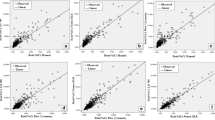Abstract
Reticulocyte count is a basic test in hematology. This study was done to compare manual and automated methods and to study the effect of sample storage on reticulocyte count. Analyses of samples (n = 86) were done at 2, 6, 24 and 48 h after blood collection. Manual counting was done from both freshly prepared slide and stored slide by microscopy on new methylene blue stained smears. Automated enumeration was on Sysmex XT-2000i analyser (Ret search II). The values of immature reticulocyte fraction (IRF) and low fluorescence reticulocytes (LFR) were also recorded. Comparison between two methods was done by Spearman’s correlation and Mann–Whitney test. Effect of storage was analysed by repeated measures ANOVA. There was strong positive correlation between both manual and automated methods at 2, 6, 24 and 48 h. The differences between the manual and automated methods were not significant at 2, 6 and 24 h (p 0.975, 0.967 and 0.227). The difference between the freshly prepared slide and stored slide were significant at 6, 24 and 48 h (p 0.015, 0.004 and 0.001). The change in reticulocyte count with time, decrease in IRF and increase in LFR were not significant up to 6 h but were significant at 24 and 48 h after blood collection. Both the methods were accurate and correlated well with each other. Freshly prepared smears for manual counting were better than counting on stored slide. Up to 6 h after blood collection results obtained by both methods are acceptable.

Similar content being viewed by others
References
Riley RS, Ben-Ezra JM, Tidwell A (2001) Reticulocyte enumeration: past & present. Lab Med 32(10):599–608
Koepke JA (1999) Update on reticulocyte counting. Lab Med 30:339–343
Siekmeier R, Bierlich A, Jaross W (2000) Determination of reticulocytes: three methods compared. Clin Chem Lab Med 38(3):245–249
Briggs C, Bain BJ (2011) Basic haematological techniques. In: Bain BJ, Bates I, Laffan MA, Lewis SM (eds) Dacie and Lewis practical haematology, 11th edn. Churchill Livingstone, Edinburgh, p 35
CLSI (2004) Methods for reticulocyte counting (Automated Blood Cell Counters, Flow Cytometry, and Supravital Dyes); Approved Guideline—Second Edition. CLSI document H44-A2, Wayne, PA: Clinical and Laboratory Standards Institute
Buttarello M, Bulian P, Prà MD, Barbera P, Rizzotti P (1996) Reticulocyte quantification by Coulter MAXM VCS (volume, conductivity, light scatter) technology. Clin Chem 42(12):1930–1937
Lacombe F, Lacoste L, Vial JP, Briais A, Reiffers J, Boisseau MR, Bernard P (1999) Automated reticulocyte counting and immature reticulocyte fraction measurement comparison of ABX PENTRA 120 Retic, Sysmex R-2000, flow cytometry and manual counts. Am J ClinPathol 112(5):677–86
Maconi M, Danise P, Cavalca L, Formisano D (2010) Flow cytometric reticulocyte counting: a comparison between two methods. J Clin Lab Anal 24(4):252–255
Simionatto M, de Paula JP, Chaves MA, Bortoloso M, Cicchetti D, Leonart MS, do Nascimento AJ (2010) Manual and automated reticulocyte counts. Hematology 15(6):406–409
Schapkaitz E, Pillay D (2015) Prolonged storage-induced changes in haematology parameters referred for testing. Afr J Lab Med [Internet] 4(1):a208
Pintér E, László K, Schüszler I, Konderák J (2015) The stability of quantitative blood count parameters using the ADVIA 2120i hematologyanalyzer. Pract Lab Med 4:16–21
de Baca ME, Gulati G, Kocher W, Schwarting R (2006) Effects of storage of blood at room temperature on Hematologic parameters measured on Sysmex XE-2100. Lab Med 37(1):28–36
Funding
This study was supported by JIPMER Intramural Grant for MSc-MLT project (JIP/Res/Intramural/Phs 1/2018- 19 dated 16–11-2018).
Author information
Authors and Affiliations
Contributions
LG performed the study, analyzed the results, and prepared the manuscript; DB co-guided the study and reviewed the manuscript; RK conceptualized and guided the study and edited the manuscript.
Corresponding author
Ethics declarations
Conflict of interest
Authors declare that they have no conflict of interest.
Ethical Approval
This study was approved by the Institute Ethics Committee (JIP/IEC/2017/0378). As no direct patient interaction or additional sampling was needed, hence waiver of consent was obtained. All were in accordance with the national ethical guidelines for biomedical and health research involving human participants as per Indian Council of Medical Research 2017 guidelines.
Additional information
Publisher's Note
Springer Nature remains neutral with regard to jurisdictional claims in published maps and institutional affiliations.
Rights and permissions
About this article
Cite this article
George, L., Basu, D. & Kar, R. Comparison Between Manual and Automated Methods of Counting Reticulocytes and the Effect of Sample Storage on Reticulocyte Count: A Cross-Sectional Study from Southern India. Indian J Hematol Blood Transfus 38, 106–110 (2022). https://doi.org/10.1007/s12288-021-01424-x
Received:
Accepted:
Published:
Issue Date:
DOI: https://doi.org/10.1007/s12288-021-01424-x




